Abstract
Because of the impact of lubrication on the efficiency and the lifecycle cost and emissions, the lubricating-oil consumption (LOC) is one of the key indicators in the research and development of internal combustion engines. State-of-the-art methods for LOC measurement are based on the use of a certain tracer to track the oil consumption. However, all of the currently available tracers have their downsides (e.g., the use of a radioactive tracer, corrosive emissions, etc.). Therefore, in the course of this research project, a new tracer substance that is based on a stable nonradioactive isotope of hydrogen—deuterium—was developed and tested thoroughly. The LOC is monitored by a hydrogen/deuterium isotopic ration in the exhaust gas by using an isotopic water analyzer. Tribologically important properties, such as the viscosity, stability, and compatibility of the tracer were investigated by laboratory experiments by using several tools, such as infrared spectroscopy, gas chromatography, thermogravimetry, etc. The properties relevant to the applicability of the method, such as the accuracy and the reproducibility, were investigated by engine test-bench experiments. Finally, long-term stability tests of the tracer were conducted with a field test.
Keywords:
lubrication; oil consumption; tracer; deuterium; infrared spectrometry; gas chromatography 1. Introduction
The development of new materials and the design of smarter components are irreplaceable parts for the future development of internal combustion engines towards lower emissions, a lifecycle cost balance, and higher reliability. All of the new components and new materials have to be validated and compared with accurate and relatable measurements. Therefore, the development of accurate and reliable analytic methods plays a vital role in future development [1,2].
Accurate online lube-oil-consumption measurement is considered to be a crucial technology for the optimization of the engine operation. High oil consumption contributes to the emissions of unburned hydrocarbons and small particles (soot), which are health issues [3,4]. Furthermore, the sulfur-and-phosphorus-based compound that is contained in lube oil poisons precious metals in aftertreatment catalysts, which lowers their service life. The remaining oil droplets in the combustion chamber could cause combustion anomalies, such as preignition, which result in the knocking of an engine [5,6,7].
On the other hand, sufficient lubrication is a critical factor in the efficiency and robustness of the engine. Higher efficiency due to lower friction, and a longer service life of the components due to lower wear, improve the lifecycle cost balance of the engine [8]. A reliable online oil-consumption method is a crucial tool for finding the sweet spot in these contradictory phenomena. This is even more important for the implementation of new alternative fuels, such as hydrogen and methanol or ammonia, where significantly different fuel–oil interactions occur [9,10].
For online lube-oil-consumption measurement, several approaches have already been developed. The detection principle, for all the methods, is based on measuring the concentration of a specific substance “tracer” in the exhaust gas. These methods can be divided into two groups: the first uses stable isotopes as the tracer, and the second uses radioactive tracers. The radioactive tracer methods include the following: tritium (3H, T) (β− decay, t1/2 = 12.32 years) [11,12], bromine (82Br) (β− decay, t1/2 = 35.30 h) [13], or germanium (69Ge) (β+ decay resulting in γ ray, t1/2 = 39.05 h) [14]. A huge advantage of radioactive tracer methods is high accuracy, even under very low concentrations of the tracer. A low concentration of the tracer is beneficial so as to not affect the physical and chemical properties of the lube oil with the addition of a huge amount of a different compound. On the other hand, working with radioactive substances is a big health hazard for engine operators and is strictly regulated. This leads to an extremely high cost for using radioactive tracers, which prohibits wider use.
The second approach uses stable tracers: either naturally abundant substances in lube oil, such as sulfur [15] and zinc [16], or the addition of a synthetic tracer with a unique composition. The specific fingerprints of these tracers are detected in the exhaust gas. Synthetic tracers can include the following: halogenated organic compounds (Cl, Br) [17], barium salts [18], and many others. The disadvantage of this approach is the necessity of adding significant amounts of tracer, which can influence the properties of the lube and can cause other issues (for example, burned halogenated compounds cause the corrosion of engine parts).
A method that is also worth mentioning uses the natural presence of sulfur in lube oil. The sulfur compounds are oxidized to sulfur dioxide (SO2), which can then be detected via mass or laser spectroscopy [15]. However, this method requires the use of sulfur-rich oil. The origin of the sulfur is mostly from lube-oil additives, which are currently being replaced with nonsulfur additives, which are mostly in synthetic and semisynthetic oils. This leads to the very poor accuracy of this method.
The use of a stable, nonradioactive isotope of hydrogen (deuterium (2H, D)) as a tracer provides the unique opportunity to use molecules of hydrocarbons, which are the basic components of the lube oil, as a tracer. The hydrogen atoms in hydrocarbon molecules can be exchanged for deuterium. This modification has a negligible effect on the physical and chemical properties of the molecules.
The measurement principle is based on the determination of the deuterium concentration in the exhaust gas. The combusted or evaporated deuterium-enriched lube oil is carried with exhaust gas to the catalytic converter, where all of the unburned hydrocarbons are oxidized to water and carbon dioxide [19]. Then, the deuterium concentration (hydrogen/deuterium ratio) is measured via an isotopic water analyser that is based on cavity ring-down spectroscopy. The final lube-oil consumption is recalculated from the hydrogen/deuterium ratio and the mass balance (oil/fuel consumption) (Figure 1).
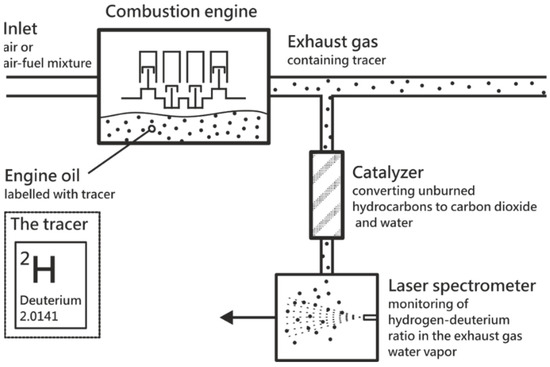
Figure 1.
The schematic of online LOC measurement based on deuterium tracer.
This method has already been successfully tested on a gasoline passenger car engine. The test campaigns prove that an addition of 5 wt.% of the deuterium tracer to the lube oil ensures a very accurate measurement of the lube-oil consumption [20,21].
The next chapters will guide the reader through the process of selecting a proper deuterium tracer with minimal impact on the physical and chemical properties of the lube oil.
2. Materials and Methods
This chapter will briefly introduce the reader to the method of the online measurement of lube-oil consumption by using a deuterated tracer, and to the methods that are used in its selection process.
2.1. Online Lube-Oil-Consumption Measurement
Oil consumption in an internal combustion engine is mainly caused by two processes. The major path is oil evaporation. The evaporated oil is consequently carried by the exhaust gas in the form of fog or small droplets. These contribute to the emissions of volatile organic compounds (VOCs). The second path is the direct combustion of the lube oil into carbon dioxide (CO2), water (H2O), and small particles (soot) [22].
This novel method is based on measuring the ratio (1H/2H (D)) between the two stable isotopes of hydrogen, protium (“hydrogen”) and deuterium, in the exhaust gas. The average hydrogen/deuterium ratio, in nature, is 99.984 at% 1H to 0.0156 at% D. This ratio remains within small fluctuations for all substances on the earth, including fuels and lubrication oils. Increasing the deuterium (D, 2H) concentration in the lubricating oil to 2–4 at% (roughly 200 times higher compared to the natural abundance) enables a very accurate measurement of the of lube-oil consumption. The evaporated or combusted deuterium-enriched oil is carried to the catalyst as a part of the exhaust gas. The remaining oil droplets are oxidized on the precious-metal-catalyst surface, together with unburned fuel. The fully oxidized exhaust gas enters a cavity ring-down spectrometer (CRDS) Picarro—L2130-i Isotope and Gas Concentration Analyzer, which determines the hydrogen/deuterium ratio. The oil consumption is, afterwards, recalculated by setting up a mass balance, while taking into account the contributions of the oil, fuel, and intake air humidity. The path of the lubricating oil and the respective tracer, from the engine to the spectrometer, is depicted in Figure 2.
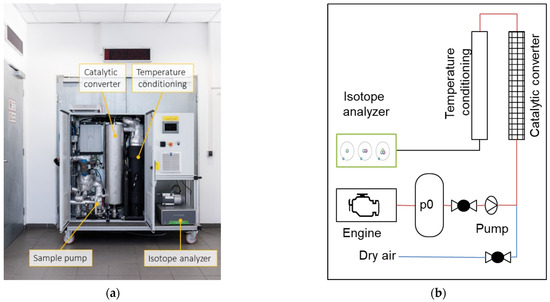
Figure 2.
(a) The measurement device; (b) the respective flow schematic.
The lube-oil-consumption method has already shown universal applicability in terms of the engine size, fuel, and the combustion concept. The method showed good reproducibility not only for stationary measurements, but also for the compilation of complete engine-characteristic maps, as depicted in Figure 3.
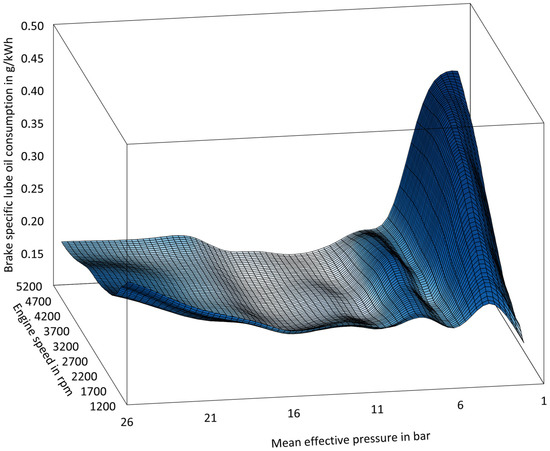
Figure 3.
Engine-characteristic map of lubricating-oil consumption.
This result was recorded on a 3-cylinder passenger car engine with a displacement of 1 L. The oil used was SAE 5W30 grade. Due to reasons of confidentiality, a more detailed description of the test carrier is not possible at this point. For these experiments, the reproducibility was within a range of 0.01–0.03 g/kWh for most of the operating range (Figure 4). Only at part load was the maximum deviation between two operating points 0.15 g/kWh; however, it is assumed that this was mainly caused by irreproducible engine conditions at the lowest load and highest speed. The theoretic measurement uncertainty of the method that was calculated by Gaussian error propagation, and by taking into account all of the mass flow measurements and their respective deuterium concentrations, was found to lie in a range between 0.01 and 0.03 g/kWh, depending on the operating point. As a reference system, the more conventional sulfur dioxide (SO2) method was used. However, the reproducibility and the accuracy of the SO2 method were not satisfactory because of the low sulfur content of the semisynthetic engine oil.
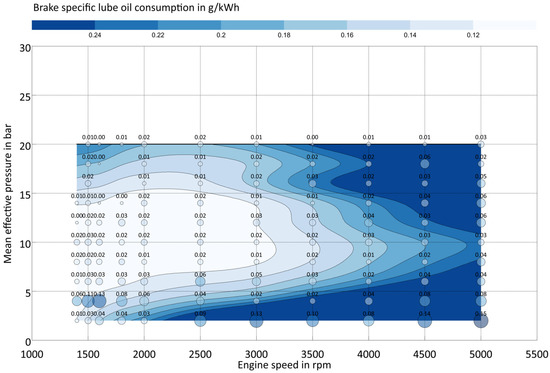
Figure 4.
Reproducibility assessment of the LOC measurement method. The numbers and sizes of the dots represent standard deviations between measurements.
2.2. Analytic Methods
2.2.1. Infrared Spectrometry (IR)
The concentration of deuterium in the lube oil was determined by Fourier transform infrared spectrometer (FTIR) (ERASPEC OIL, from the company eralytics GmbH (Langenzersdorf, Austria)). The exact concentration was determined by using calibration with 1H-nuclear magnetic resonance (NMR) spectroscopy, and an area of a very specific absorption band of a deuterium–carbon bond between 2050 and 2250 cm−1. The deuterium concentration shows a linear dependency on the area of this specific absorption band (Figure 5).
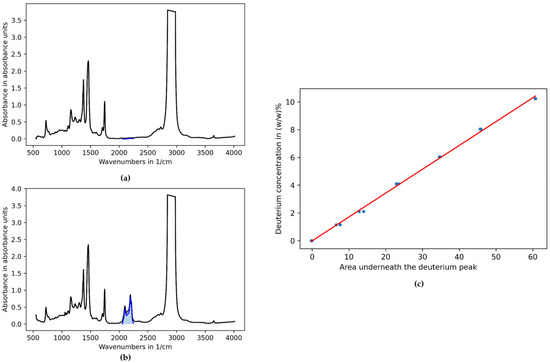
Figure 5.
The complete IR spectrum of the lube oil: (a) without tracer; and (b) with tracer (black), including the selected area for the determination of the deuterium concentration (blue); (c) linear correlation between 2H concentration and area in the IR spectrum.
2.2.2. Viscosity and Viscosity Index
For the determination of the kinematic, dynamic viscosity and the viscosity index, the standard viscosimeter for oil analysis (SVM 3000 Stabinger Viscometer, from the company Anton Paar GmbH (Graz, Austria)) was used.
2.2.3. Gas Chromatography (GC)
GC measurements were performed on an Agilent Technologies (Santa Clara, CA, USA) 7890A (G3440A) GC system equipped with an Agilent Technologies J&W GC-column HP-5MS ((5%-phenyl)-methylpolysiloxane; length: 30 m; inner diameter: 0.250 mm; film: 0.25 μm) at a constant helium flow rate (He: 5.0; Air Liquide; “Alphagaz”; 1.085 mL/min; average velocity: 41.6 cm/s).
2.2.4. Thermogravimetry
Thermogravimetry analyses were performed on an STA 409 CD (simultaneous thermal analyzer from the company Netzsch-Gerätebau GmbH (Selb, Germany)). The analysis was performed in a range from 50 to 1000 °C, at 10°/min.
3. Results and Discussion
3.1. Deuterated Tracer
The first challenge was the proper selection of the deuterated tracer. Ideally, its addition should not influence the physical and chemical properties of the lube oil. On the other hand, the deuterated tracer must be easily available (commercial product or simple preparation) and affordable.
The best candidates were commercially available deuterated hydrocarbons (especially fully deuterated dodecane (C12D26)), deuterated tracer based on base oil, and deuterated tracer based directly on lube oil. The base oil and lube-oil-based deuterium tracer required the in-house development of preparation (deuterium labelling) (Table 1).

Table 1.
Comparison of different potential deuterium tracers.
The preparation of the deuterated tracer from the final lube oil was not successful. Both of the tested deuteration reactions (with deuterium gas and with heavy water (D2O)) failed. The most probable reason was the poisoning of the precious-metal catalyst by oil additives (especially with sulfur and phosphorus compounds).
The situation was different for the deuteration of the base oil. Some small-scale preparations of deuterated hydrocarbons and base oils have already been published. Most of the preparations use deuterium gas as a deuteration agent [23,24,25]. However, deuterium gas is the approximately 3–5 times more expensive than the same molar amount of heavy water. This is a strong argument for the use of heavy water as a deuteration agent [26,27].
The deuteration of the base oil was performed as a two-step process that was catalyzed by 0.35 wt.% Pd/C (5 wt.%). As the deuteration agent, heavy water was used. The first step of the reaction was conducted with recycled D2O (roughly 70 at% D) waste from the second step of the reaction. The second step was performed with 99.99% D2O. The reaction was carried out under an elevated temperature of 215 °C, a pressure of 22 bar, and an atmosphere of hydrogen or deuterium (1 bar) in a 5 L pressure reactor from the company UOSLAB—UKRORGSYNTEZ Ltd. (Kyiv, Ukraine). The presence of hydrogen or deuterium is mandatory for the activation of the catalyst (Figure 6).
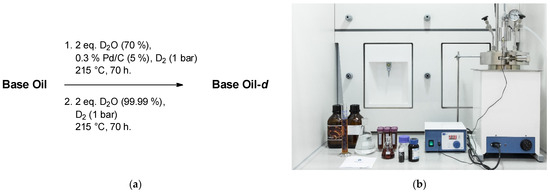
Figure 6.
(a) Reaction scheme of deuteration of base oil; (b) 5 L pressure reactor from the company UOSLAB—UKRORGSYNTEZ Ltd.
Synthetic- and mineral-based oils were tested in this deuteration reaction. Better results were achieved with a synthetic base oil (PAO). The synthetic base oils showed roughly 1.3× better conversion in the deuteration reaction than the mineral-based oil. There was not a huge difference in the reactivity of the PAO4 and PAO6 base oils. However, the lower-viscosity PAO4 base oil showed an easier reaction workup, which was mainly during the filtration for removing the catalyst (Pd/C (5 wt.%)) (Table 2).

Table 2.
Reaction results for different base oils.
The PAO4 base oil was identified as the best-suited candidate for the deuterated oil tracer in terms of preparation. The deuterated PAO4 base oil (PAO4-d) was called the LEC OilTracer.
The main ingredients of PAO4 base oil are hydrogenated trimers of dec-1-ene (C30H62, CAS: 500-393-3). The most abundant isomer can be seen in Figure 7.
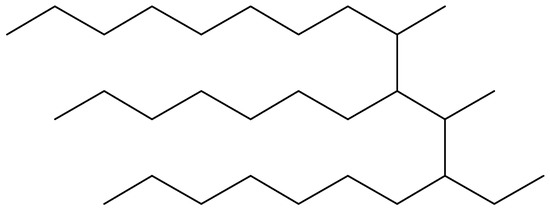
Figure 7.
The main ingrediency of PAO4 oil—hydrogenated trimers of dec-1-ene.
As mentioned in the previous section on the oil-consumption method, the limit for accurate oil-consumption measurement is around 3–4 at% deuterium, which roughly corresponds to the deuterium concentration of 0.75–1 wt.% in the lube oil. This number is relatively abstract, and it is hard to imagine how much oil tracer would have to be added. Table 3 shows the wt.% and the amount of deuterated tracer that has to be added to reach the required concentration.

Table 3.
The required amount of tracer for accurate LOC measurement.
3.2. Viscosity and Viscosity Index
For reliable and authentic measurement, the addition of the tracer should not significantly influence the properties of the lube oil. The crucial characteristics are the viscosity and the viscosity index. The critical parameter for the decision was the kinematic viscosity at 100 °C and the viscosity index, because those values represent behavior of the lube-oil operating temperature. Our goal was to not influence the kinematic viscosity at 100 °C for more than 10%.
The first tests were on a “deuterated hydrocarbon tracer”. This measurement was performed with nondeuterated n-dodecane (C12H26). The physical and chemical properties are nearly identical. As a lube oil, mineral base oil was used.
As mentioned in the previous chapter, the addition of 3–4% of deuterated hydrocarbon tracer should ensure a sufficient concentration of deuterium in lube oil. Unfortunately, already a very small addition of the n-dodecane (C12H26) caused drastic changes in the kinematic viscosity (Table 4). By the addition of 2 wt.% of n-dodecane (C12H26), the kinematic viscosity at 100 °C dropped by 12%. Such a significant shift in the viscosity would influence the engine operation. Therefore, this type of tracer is not suitable for lube-oil-consumption measurement.

Table 4.
Kinematic viscosity of blended mineral lube oil with n-dodecane (C12H26).
The second viscosity measurement was performed with the LEC OilTracer (PAO4-d). For easy comparison, the same mineral lube oil was use.
The deuterium-enriching lube oil by the addition of the LEC OilTracer shows considerably different results (Table 5). The decrease in the kinematic viscosity at 100 °C was not significant. There was only a 5% drop in the kinematic viscosity at 100 °C for a 4 wt.% addition, which was sufficient for accurate lube-oil-consumption measurement. The internal threshold of a 10% deviation from the viscosity of pure oil was exceeded only with the addition of 10 wt.% of the LEC OilTracer.

Table 5.
Kinematic viscosity of deuterium-enriched mineral base oil with LEC OilTracer.
The best results were achieved with the LEC OilTracer (PAO4-d) and semisynthetic lube oil. For an example, the viscosity measurement with Titan SuperSyn 5W-30 from Fuchs is listed in Table 6. The internal threshold of the 10% deviation from the viscosity of pure oil was not exceeded, even with the addition of 10 wt.% of the LEC OilTracer, which is far beyond the required concentration.

Table 6.
Kinematic viscosity of deuterium-enriched Titan Supersyn 5W-30 with LEC OilTracer.
3.3. Compatibility and Stability
It would be possible to use a broad range of deuterated substances for enriching the deuterium content of lube oil. The vital parameters are not only the tribological properties of the tracer, but also the stability under harsh conditions and the high similarity in terms of the evaporation and the boiling points.
The low chemical stability of the tracer would cause decomposition and inconsistency in the measurement.
A different boiling point (evaporation rate) of the tracer, in comparison to lubrication oil, would result in a different speed of evaporation. For example: if the boiling point of the tracer were to be lower than the based oil of lube oil, the tracer would evaporate faster, and the measured oil consumption would be higher than the real oil consumption.
3.3.1. Thermogravimetry
Thermogravimetry can, in principle, answer both questions. The weight of a measured sample was continuously monitored while the sample was heated, which, in this particular case, was from 50 to 1000 °C by 10 °/min. The sample was in an open vessel; therefore, after reaching the boiling point, the sample evaporated and its weight decreased. The loss of the weight could also be observed during the decomposition of the sample, in which gaseous or lower-boiling-point side products were created.
Additionally, thermogravimetry was used for comparing the boiling point (evaporation curve) and the stability to the nondeuterated substance, which should stay in a similar range. This also facilitates the verification of the purity of the product. It can contain lower boiling fractions that are created during the deuteration reaction via the thermal decomposition reaction (cracking).
Figure 8 shows that there is no weight loss below 200 °C. From this, we can assume that the LEC OilTracer does not contain lower boiling fractions, and that its synthesis is without the cracking side reaction.
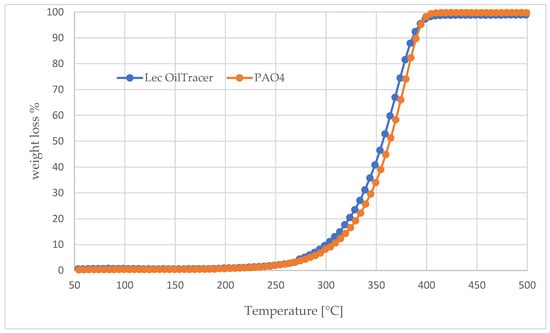
Figure 8.
Comparison of thermogravimetry analysis of PAO4 oil and LEC OilTracer.
Major weight loss takes place between 300 and 400 °C, which is exactly in the same range as the PAO4 base oil. This range also corresponds to the “boiling points” of other base oils that are used for the production of lube oils [28].
The evaporation curve of the LEC OilTracer is very slightly shifted to the left in comparison to the PAO4 base oil. This trend is caused by the exchange of hydrogen atoms for deuterium. Most of the hydrocarbons have slightly lower boiling points [29].
3.3.2. Gas Chromatography/Mass Spectroscopy (GC-MS)
The next method that was used for the verification of the purity was GC-MS. Gas chromatography detects the presence of side products. The separation of the compounds is mostly based on their boiling points and the interactions with the column material. Lower boiling fractions and products of the cracking side reaction would elute before (with a lower retention time) the main fraction. Associated mass spectroscopy would be able to identify the exact substance.
As can be seen from the GC-MS chromatogram of the PAO4 base oil and the LEC OilTracer (Figure 9), a significant peak shift, or some different peaks, before or after the main fraction of the LEC OilTracer, were not observed. This nicely confirms the purity of the LEC OilTracer and the stability of the PAO4 base oil during the deuteration reaction (the presence of some peaks with lower retention times would indicate side reactions during the synthesis “cracking”).
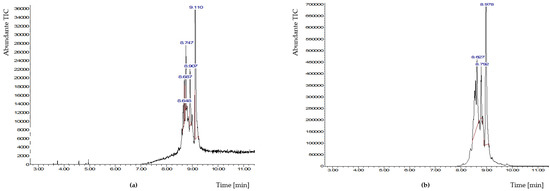
Figure 9.
(a) GC-MS analysis of PAO4 base oil, and (b) LEC OilTracer. On the x-axis is the retention time, and on the y-axis is the total ion current (TIC).
3.4. Long-Term Stability Test—A Truck Diesel Engine
The final test of the stability and the usability of the deuterated tracer was a long-term study on a diesel truck engine. The test was performed on a delivery truck in ordinary traffic in Austria. For this experiment, 1 wt.% of the LEC OilTracer was added to the lube oil. The main focus of this investigation was monitoring the changes in the deuterium concentration in the lube oil in order to prove that the deuterium concentration does not fluctuate or shift over the engine time and mileage. This was achieved by measuring the deuterium content with IR spectrometry at multiple points during the study.
- Truck type: Mercedes Actros 2545 L/49 6*2
- Engine type: OM 471 LA.6-13
- Oil type: Fuchs Titan Cargo Maxx 10W40, Volume: 38.2 L,
- Tracer added: 0.38 L (1 wt.%) (LEC OilTracer)
As can be seen from Figure 10, there were no significant decreases or increases in the deuterium tracer in the lube oil. The most significant decreases in the concentration are visible during the refilling of the consumed lube oil (blue curve). The consumed lube oil was replaced by fresh oil without a deuterated tracer. The sharp drops in concentration were caused by these additions (e.g., 652 h; the addition of 3 L of fresh oil; a 9% drop). The orange curve shows the deuterium concentration with the correction for these additions.
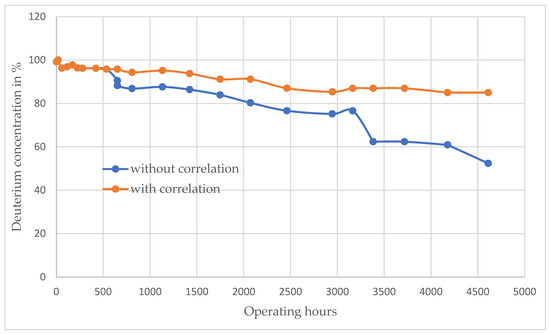
Figure 10.
Deuterium concentration in lube oil during long-term stability test in a truck diesel engine.
Overall, the measurement shows a very negligible drop in the deuterium content in the lube oil. The deuterium content difference was only 15% over 4600 operating hours and a mileage of nearly 150,000 km.
These results, plus the fact that the operation of the engine was without defect or error, confirm the stability and the compatibility of the deuterated tracer with the lube oil.
The inspection of the engine after the test did not find any defect or deposits of the tracer in the engine.
4. Conclusions
Deuterium is a stable, nonradioactive isotope of hydrogen that can be used for highly accurate online lube-oil-consumption measurement [20,21]. The major goal of the research that is presented in this publication was the identification of a suitable deuterium tracer for enriching the concentration of deuterium in lube oil. An ideal deuterium tracer should have identical or highly similar properties to lube oil (boiling point, viscosity, etc.) and a high concentration of deuterium.
In the beginning, three different categories of the oil tracer were identified: commercially available deuterated hydrocarbons, deuterated base oil, and deuterated lube oil. The last two categories required in-house development and preparation.
The closest commercially available deuterated substances are polydeuterated linear hydrocarbons, such as n-dodecane-d (C12D26). However, they turned out to be very poor candidates, which was mainly due to the incompatibility in the viscosity and the boiling point.
Tracers that are based on deuterated base oil or lube oil are not commercially available. First, it was necessary to develop an easy and affordable method of synthesis. The deuteration of lube oil failed, which was most probably due to the poisoning of the catalyst with additives. However, the deuteration of the synthetic base and mineral-based oil was successful. The synthetic-based oil PAO4 was identified as the best candidate for large-scale synthesis. Later on, the synthesis was scaled up to kilogram production. The final deuterium tracer (PAO4-d (LEC OilTracer)) contained an average of 75 at% of deuterium.
For accurate lube-oil-consumption measurement, it is necessary to enrich the concentration of deuterium in the lube oil to 0.75–1 wt.%. This concentration can be achieved by the addition of 4–5 wt.% of LEC Oiltracer (PAO4-d) to the lube oil. As shown above, this addition does not significantly influence the kinematic viscosity of the lube oil (less than a 5% deviation). This small deviation can probably be eliminated by the addition of viscosity improvers to the LEC Oiltracer (PAO4-d), and this is the subject of our future research.
The thermogravimetry-and-gas-chromatography analysis proved that the evaporation rate of the LEC OilTracer (PAO4-d) is very similar to the evaporation rate of base oils, which are used for the production of lube oils. This indicates that the concentration of LEC OilTracer will not fluctuate during the experiment. This was also confirmed by a long-term stability study on a truck diesel engine. The concentration of the tracer was highly stable over time, and it decreased by only 15% over 4600 operating hours and a mileage of 150,000 km.
PAO4-d (LEC OilTracer) was identified as a very promising deuterium tracer for online lube-oil-consumption measurement, and it has already been successfully tested on a gasoline passenger car engine [20,21].
Future investigations will include large stationary gas engines that operate on natural gas and hydrogen, where the lube-oil consumption plays a crucial role in combustion anomalies, such as preignition, which results in the knocking of an engine.
5. Patents
- Title: Verfahren zur Bestimmung von Isotopenverhältnissen
- Method for determining isotope ratios
- Application Number: A 51070/2019
- Granted: 15 November 2021
- State: Granted/Registered
- Applicant: LEC GmbH
- Representative: Hüberscher & Partner Patent Attorneys GmbH
- Inventors: Bernhard Rossegger and Michael Engelmayer
Author Contributions
Conceptualization, M.V.; methodology, M.V., B.R. and F.N.-F.; software, B.R.; validation, B.R. and M.V.; formal Analysis, M.V. and B.R.; investigation, M.V. and B.R.; resources, M.V. and B.R.; data curation, M.V. and B.R.; writing—original draft preparation, M.V.; writing—review and editing, B.R. and F.N.-F.; visualization, M.V. and B.R.; supervision, M.E.; project administration, Andreas Wimmer; funding acquisition, M.E. and A.W. All authors have read and agreed to the published version of the manuscript.
Funding
This research was funded by the Austrian Federal Ministry for Transport, Innovation and Technology (BMVIT), the Austrian Federal Ministry for Digital and Economic Affairs (BMDW) and the Provinces of Styria, Tyrol and Vienna: “COMET—Competence Centres for Excellent Technologies” Programme: K1-Centre LEC EvoLET. The COMET Programme is managed by the Austrian Research Promotion Agency (FFG). Project partners: “Kristl, Seibt und Co. GmbH”, “Forschungsgesellschaft für Verbrennungskraftmaschinen und Thermodynamik mbH” and the “Institute of Internal Combustion Engines and Thermodynamics” of the Graz University for Technology.
Data Availability Statement
No new data were created or analyzed in this study. Data sharing is not applicable to this article.
Acknowledgments
The authors would like to acknowledge eralytics GmbH (Vienna, Austria) for their support in terms of installation and handling, and for the generous provision of the ERASPEC OIL portable FTIR device. Furthermore, they would like to acknowledge USOLAB—UKRORGSYNTEZ Ltd. (Kiev, Ukraine) for their support in terms of the installation and handling of the high-pressure reactor. In addition, the authors would like to express special thanks to Professor Rolf Breinbauer from the Institute of Organic Chemistry, and to Albrecht Leis from JR AquaConSol GmbH for sharing their comprehensive knowledge and laboratory equipment, and to Ansel Higgs from LEC GmbH for help with the reviewing and editing. The authors would like to acknowledge the financial support of the ‘‘COMET—Competence Centres for Excellent Technologies’’ Programme of the Austrian Federal Ministry for Transport, Innovation and Technology (BMVIT), the Austrian Federal Ministry for Digital and Economic Affairs (BMDW) and the Provinces of Styria, Tyrol and Vienna for the K1-Centre LEC EvoLET. The COMET Programme is managed by the Austrian Research Promotion Agency (FFG). The authors would like to express their sincere thanks to our project partners, “Kristl, Seibt und Co. GmbH”, “Forschungsgesellschaft für Verbrennungskraftmaschinen und Thermodynamik mbH” and the “Institute of Internal Combustion Engines and Thermodynamics” of the Graz University for Technology.
Conflicts of Interest
The authors declare no conflict of interest.
Abbreviations
| wt.% | Weight percent |
| at% | Atom percent |
| 1H | Protium |
| 2H; D | Deuterium |
| 3H; T | Tritium |
| LOC | Lube-oil consumption |
| FTIR | Fourier transform infrared spectroscopy |
| IR | Infrared |
| NMR | Nuclear magnetic resonance |
| Pd | Palladium |
| PAO | Polyalphaofeline |
| LEC OilTracer | Deuterated PAO4 base oil (PAO4-d) |
| CG | Gas chromatography |
| MS | Mass spectroscopy |
| VI | Viscosity index |
References
- Breiteneder, T.; Schubert-Zallinger, C.; Wimmer, A.; Vyštejn, J.; Hager, G.; Schallmeiner, S. Innovative Instrumented Sliding Bearings as a New Approach to On-Board Bearing Monitoring. In Proceedings of the ASME 2019 Internal Combustion Engine Division Fall Technical Conference; American Society of Mechanical Engineers, Chicago, IL, USA, 20–23 October 2019. [Google Scholar]
- Posch, S.; Winter, H.; Zelenka, J.; Pirker, G.; Wimmer, A. Development of a Tool for the Preliminary Design of Large Engine Prechambers Using Machine Learning Approaches. Appl. Therm. Eng. 2021, 191, 116774. [Google Scholar] [CrossRef]
- Amirante, R.; Distaso, E.; Napolitano, M.; Tamburrano, P.; Iorio, S.D.; Sementa, P.; Vaglieco, B.M.; Reitz, R.D. Effects of Lubricant Oil on Particulate Emissions from Port-Fuel and Direct-Injection Spark-Ignition Engines. Int. J. Engine Res. 2017, 18, 606–620. [Google Scholar] [CrossRef]
- Abdel-Rahman, A.A. On the Emissions from Internal-Combustion Engines:A Review. Int. J. Energy Res. 1998, 22, 483–513. [Google Scholar] [CrossRef]
- Schweizer, T.; Zöbinger, N.; Eder, M.; Schießl, R. Initial Pre-Ignition; FVV: Frankfurt, Germany, 2021. [Google Scholar]
- Welling, O.; Moss, J.; Williams, J.; Collings, N. Measuring the Impact of Engine Oils and Fuels on Low-Speed Pre-Ignition in Downsized Engines. SAE Int. J. Fuels Lubr. 2014, 7, 1–8. [Google Scholar] [CrossRef]
- Tormos, B.; Garcia-Oliver, J.M.; Bastidas, S.; Domínguez, B.; Oliva, F.; Cárdenas, D. Investigation on Low-Speed Pre-Ignition from the Quantification and Identification of Engine Oil Droplets Release under Ambient Pressure Conditions. Measurement 2020, 163, 107961. [Google Scholar] [CrossRef]
- Delprete, C.; Razavykia, A. Piston Dynamics, Lubrication and Tribological Performance Evaluation: A Review. Int. J. Engine Res. 2020, 21, 725–741. [Google Scholar] [CrossRef]
- Shukla, D.S.; Gondal, A.K.; Nautiyal, P.C. Effect of Methanol Fuel Contaminants in Crankcase Oils on Wear. Wear 1992, 157, 371–380. [Google Scholar] [CrossRef]
- Miller, A.L.; Stipe, C.B.; Habjan, M.C.; Ahlstrand, G.G. Role of Lubrication Oil in Particulate Emissions from a Hydrogen-Powered Internal Combustion Engine. Environ. Sci. Technol. 2007, 41, 6828–6835. [Google Scholar] [CrossRef]
- Evans, R. A Tritium-Tracer Technique for the Measurement of Oil Consumption in Gasoline and Diesel Engines. Int. J. Appl. Radiat. Isot. 1973, 24, 19–27. [Google Scholar] [CrossRef]
- Lucas, L.L.; Unterweger, M.P. Comprehensive Review and Critical Evaluation of the Half-Life of Tritium. J. Res. Natl. Inst. Stand. Technol. 2000, 105, 541–549. [Google Scholar] [CrossRef]
- Zellbeck, H.; Bergmann, M.; Röthig, J.; Seibold, J.; Zeuner, A. A Method of Measuring Oil Consumption by Labelling with Radioactive Bromine. Tribotest 2000, 6, 251–265. [Google Scholar] [CrossRef]
- Robota, A.; Plückers, J.; Delvigne, T.; Courtois, O. Oil Emission Measurement For A Holistic Estimation Of Oil Consumption; Fachmedien Wiesbaden GmbH: Wiesbaden, Germany, 2015. [Google Scholar]
- V&F Analyse; Messtechnik GmbH. IMR-MS—How It Works; Technical Description: Absam; Messtechnik GmbH: Duisburg, Germany, 2013. [Google Scholar]
- Sellmeier, S. Laserspektroskopische Spurenanalytik von Ölbestandteilen in Abgasen von Verbrennungsmotoren. Ph.D. Dissertation, Technische Universität München, Munich, Germany, 2011. [Google Scholar]
- Lee, P.S.; Majkowski, R.F.; Schreck, R.M. Method for Determining Fuel and Engine Oil Consumption Using Tunable Diode Laser Spectroscopy, General Motors Corporation. U.S. Patent 4,990,780, 5 February 1991. [Google Scholar]
- Rossegger, B.; Schubert-Zallinger, C.; Wimmer, A. Lube Oil Consumption Measurement On Internal Combustion Engines. In Proceedings of the STLE Annual Meeting, Atlanta, GA, USA, 21–25 May 2017. [Google Scholar]
- He, C.; Cheng, J.; Zhang, X.; Douthwaite, M.; Pattisson, S.; Hao, Z. Recent Advances in the Catalytic Oxidation of Volatile Organic Compounds: A Review Based on Pollutant Sorts and Sources. Chem. Rev. 2019, 119, 4471–4568. [Google Scholar] [CrossRef]
- Rossegger, B.; Leis, A.; Vareka, M.; Engelmayer, M.; Wimmer, A. Lubricating Oil Consumption Measurement on Large Gas Engines. Lubricants 2022, 10, 40. [Google Scholar] [CrossRef]
- Rossegger, B.; Eder, M.; Vareka, M.; Engelmayer, M.; Wimmer, A. A Novel Method for Lubrication Oil Consumption Measurement for Wholistic Tribological Assessments of Internal Combustion Engines. Tribol. Int. 2021, 162, 107141. [Google Scholar] [CrossRef]
- Soejima, M.; Harigaya, Y.; Hamatake, T.; Wakuri, Y. Study on Lubricating Oil Consumption from Evaporation of Oil-Film on Cylinder Wall for Diesel Engine. SAE Int. SAE Int. J. Fuels Lubr. 2017, 10, 487–501. [Google Scholar] [CrossRef]
- Atkinson, J.G.; Luke, M.O.; Stuart, R.S. A Direct Preparation of Fully Deuterated High-Molecular-Weight Hydrocarbons. Chem. Commun. 1967, 10, 474. [Google Scholar] [CrossRef]
- Atkinson, J.G.; Luke, M.O.; Stuart, R.S. A Simplified Preparation of Fully Deuterated, High Molecular Weight Hydrocarbons. Can. J. Chem. 1967, 45, 1511–1518. [Google Scholar] [CrossRef]
- Atkinson, J.G.; Luke, M.O.; Stuart, R.S. The Mechanism of Exchange between Deuterium and Alkanes in the Liquid Phase. J. Chem. Soc. D 1969, 6, 283. [Google Scholar] [CrossRef]
- Sajiki, H.; Aoki, F.; Esaki, H.; Maegawa, T.; Hirota, K. Efficient C-H/C-D Exchange Reaction on the Alkyl Side Chain of Aromatic Compounds Using Heterogeneous Pd/C in D2O. Org. Lett. 2004, 6, 1485–1487. [Google Scholar] [CrossRef]
- Klenner, M.A.; Cagnes, M.; Wood, K.; Mita, K.; Kishimoto, M.; Darwish, T. Decagram Scale Production of Deuterated Mineral Oil and Polydecene as Solvents for Polymer Studies in Neutron Scattering. Polym. Chem. 2020, 11, 4986–4994. [Google Scholar] [CrossRef]
- Wang, Z.; Yang, C.; Yang, Z.; Brown, C.E.; Hollebone, B.P.; Stout, S.A. Petroleum Biomarker Fingerprinting for Oil Spill Characterization and Source Identification. In Standard Handbook Oil Spill Environmental Forensics; Elsevier: Amsterdam, The Netherlands, 2016; pp. 131–254. ISBN 9780128038321. [Google Scholar]
- Zhao, H.; Unhannanant, P.; Hanshaw, W.; Chickos, J.S. Enthalpies of Vaporization and Vapor Pressures of Some Deuterated Hydrocarbons. Liquid−Vapor Pressure Isotope Effects. J. Chem. Eng. Data 2008, 53, 1545–1556. [Google Scholar] [CrossRef]
Publisher’s Note: MDPI stays neutral with regard to jurisdictional claims in published maps and institutional affiliations. |
© 2022 by the authors. Licensee MDPI, Basel, Switzerland. This article is an open access article distributed under the terms and conditions of the Creative Commons Attribution (CC BY) license (https://creativecommons.org/licenses/by/4.0/).